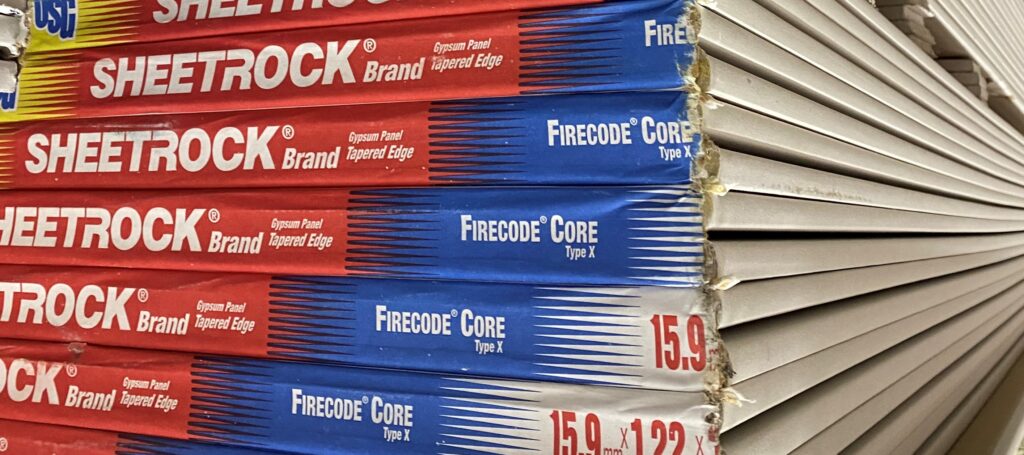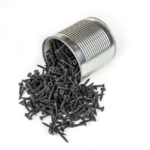Construction industry professionals can tell you they’ve been asked, when was drywall invented? But does anyone really know the real answer?
Drywall is a versatile building material used with increasing popularity over the last century. But what’s the story behind drywall? And who invented the building material that’s now used in virtually every structure built around the entire world?
When Was Drywall Invented?
To understand the history of drywall, we need to go back to the 1800s. Skilled builders used lath and plaster in new homes to finish inside walls and ceilings. While the method produced smooth and durable walls, it was labor-intensive.
There had to be a better way.
After he served as an assistant engineer in the Navy during the Civil War, Augustine Sackett turned to construction, specifically manufacturing building materials.
He quickly realized a much more efficient method to the typical lath and plaster by manufacturing gypsum between thin sheets of paper. Augustine Sackett filed a U.S. patent titled “Inside-Wall Covering” on May 23, 1890.
Even though it would be several decades before the term “drywall” would evolve, most people credit the invention of drywall to Augustine Sackett when he filed his patent in 1890.
His Sackett Board would become “drywall.” Today, drywall covers the inside of 97% of all newly constructed buildings.
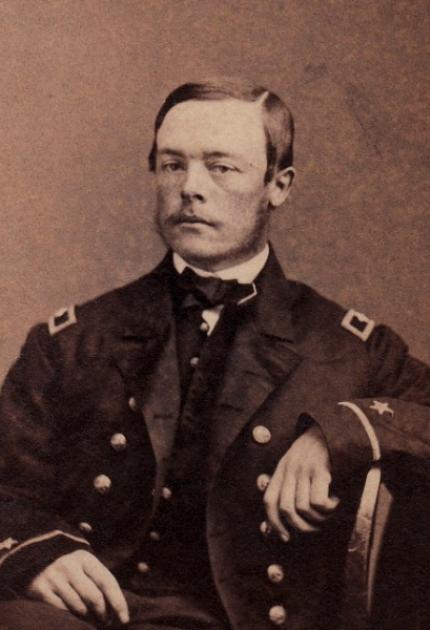
Who Invented Drywall?
Before drywall, there was Sackett Board. In 1894, Augustine Sackett was finally issued his patent No. 520123, “Inside Wall Covering,” after waiting patiently for nearly four years.
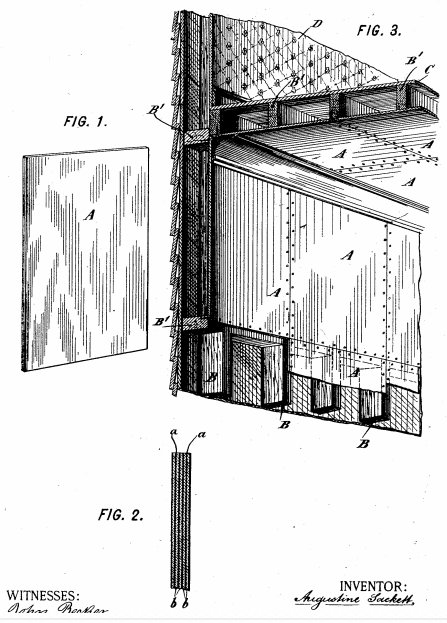
So, how did we get from Sackett Board to “Drywall?” There’s more to the story.
When asked who invented drywall, most people answer the question by simply saying Augustine Sackett invented drywall in 1916, and they move on. But that would not be accurate.
Let’s look at the timeline of exactly how we went from lath and plaster to Sackett Board to the drywall and Sheetrock that we all know and love today.
1800s up to 1890 – Lath and plaster method used on the inside of most buildings
1890 – Augustine Sackett filed his patent for Sackett Board
May 22nd, 1894 – Augustine Sackett issued U.S. Patent No. 520123 for Sackett Board
1909 – United States Gypsum Corporation (USG) purchases the Sackett Plaster Board Company and Augustine Sackett’s production facilities
1910 – USG designed a gypsum panel with a folded edge
1913 – USG eliminated all layers of paper except the bottom and top sheets, leaving a solid gypsum core. USG rebranded the sheets “Adamant Board.”
1917 – USG rebranded Adamant Board to “Sheetrock”
1945 – By the conclusion of World War II, the U.S. Military used 2.5 billion square feet of gypsum board for government structures and military bases during the war effort.
1955 – During the baby boom and suburban sprawl following the war, everyone wanted a new house, and half of those new homes were built using gypsum board.
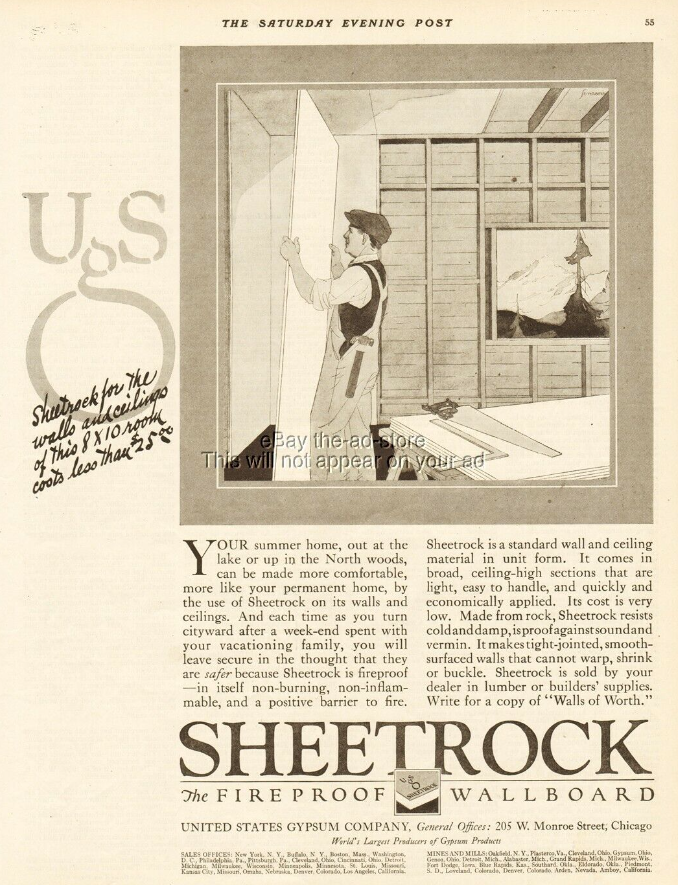
How Did Drywall Get Its Name?
When did we decide to start calling Sackett’s board drywall? The evolution of the term “drywall” is pretty simple.
Before Sackett Board, the lath and plaster method required water as part of the plaster mixture to finish interior walls. One of the big problems with using water and plaster was the necessary dry time.
With the newly invented Sackett Board, mixing and drying already occurred in the factory when the board was produced. By the time the stacks of Sackett Board showed up to the house for installation, it was already dry.
So using Sackett Board produced a “dry-wall.” Instead of a “wet plaster wall” from freshly applied plaster on lath.
When Did the Term “Drywall” Become Popular?
One quick note, the term “drywall” didn’t “stick” right away. It took several decades for the name to become popular around the country.
After World War II and through the 1950s, over 20 million new homes were built. Demand for gypsum board was off the charts, and the United States Gypsum Company was ready to accommodate.
As their Sheetrock Brand gained popularity, some confusion existed about the difference between drywall and sheetrock. (there’s still some confusion between the two names)
So the term “drywall” evolved over several decades since Augustine Sackett’s 1890 invention through USG’s marketing of their popular drywall brand called “Sheetrock.”
According to the Gypsum Association, the U.S. gypsum industry manufactures over 20 billion square feet of drywall every year.
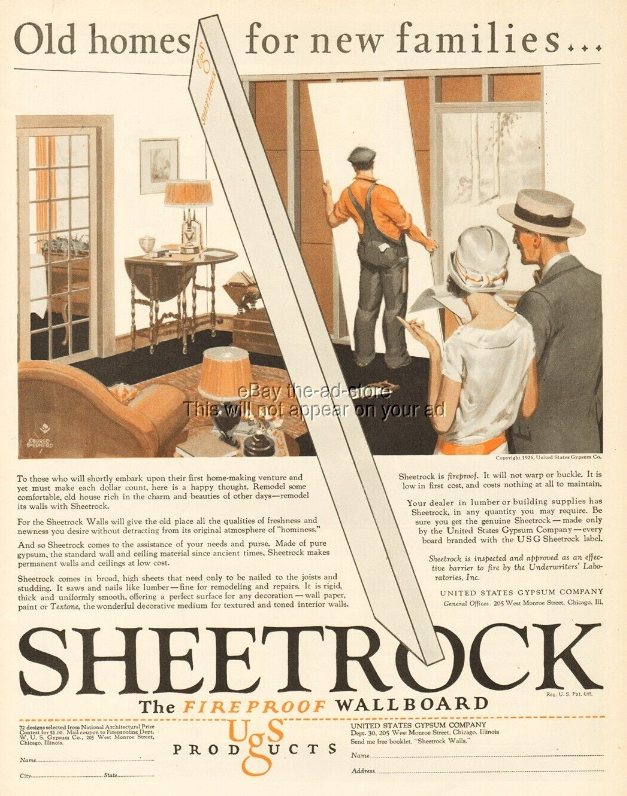
What Is Drywall Building Material Anyway?
The history of drywall is an interesting one. Despite its simplistic look, it is among the most versatile and widely used building materials today. Since the Greeks, Romans, and Babylonians used plaster, there was little change in finish methods.
Then drywall came along. Drywall sheets are simply gypsum boards attached to the house’s interior walls or ceilings.
Over the years, it’s been referred to as Sheetrock, plasterboard, wallboard, gypsum panel, buster-board, Adamant Board, and Sackett Board.
Drywall is the standard in modern home construction and has been used increasingly since its invention. It is a wall covering made of gypsum plaster and pressed into large sheets between two thick pieces of paper, creating an alternative to traditional plaster walls.
While not as durable as plaster walls, drywall is fire-resistant and comparatively easier and faster to install. With drywall, homeowners can quickly patch any holes or damage that may occur over time. Drywall has become so popular it’s now considered one of the foundations of modern home construction.
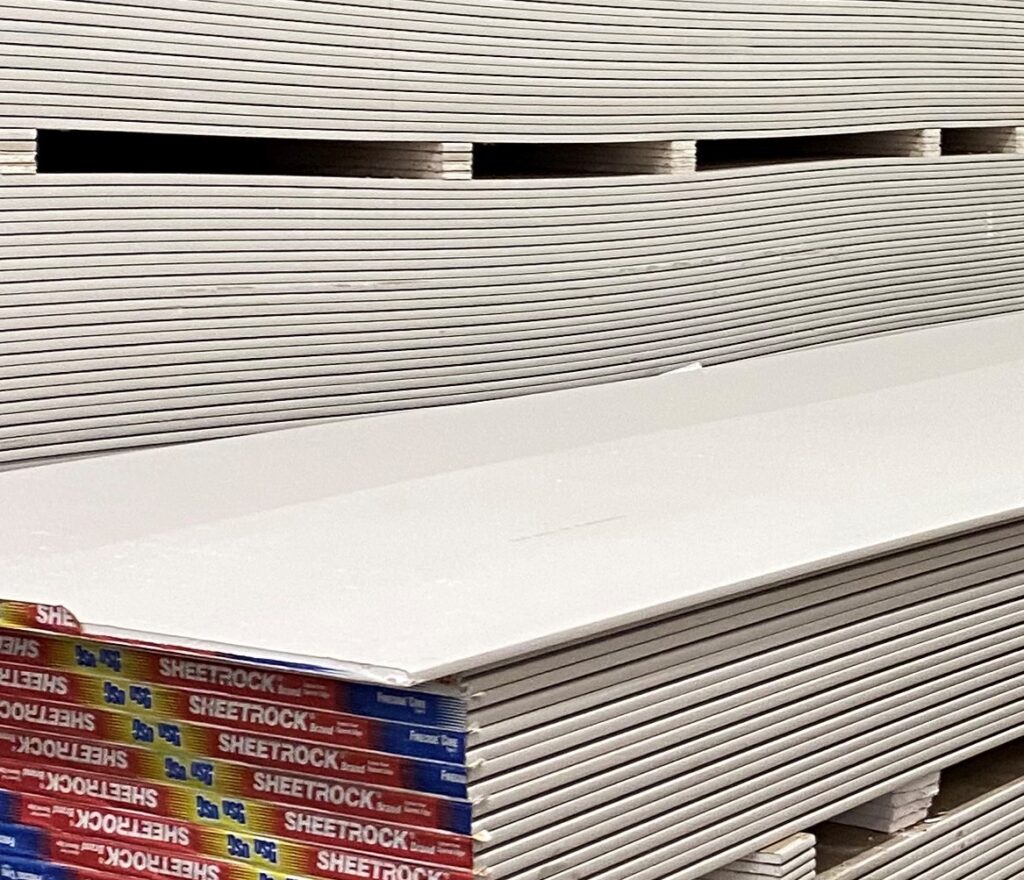
How Is Drywall Made?
To make drywall, the naturally occurring mineral element known as gypsum is pressed into a sheet and held together with special adhesives.
Special plasters, glues, gels, or other adhesives are added to improve the board’s strength and stability and help it keep its ridged shape. Then, a thin covering of two paper boards is glued to each side to give that smooth and finished look.
Drywall construction began before the 20th century, but improvements were made to make it more user-friendly and to reduce the labor and material cost of traditional lath and plaster on wood studs.
Drywall has become popular in North America, largely thanks to its affordability, durability, and adaptability. The history of drywall is vast and has been highly influential in developing modern building material creation and design processes.

Drywall is made up of multiple-layer components. At the core, it consists of a layer of plaster sandwiched between two heavy sheets of paperboard or drywall panels.
Additionally, there can be a layer of fiberglass or felt paper which acts as added protection from moisture and mold.
The drywall is then fastened to wall studs with drywall screws and sealed with tape and joint compound. Finally, the drywall is sanded and painted for a smooth finish.
Drywall is an efficient construction material that can be used in both commercial and residential buildings. It offers insulation, fire protection, and noise reduction, making it a perfect choice for many applications.
It is also cost-effective to help you create the desired look without breaking the bank. With the proper installation and maintenance, drywall can last for years.
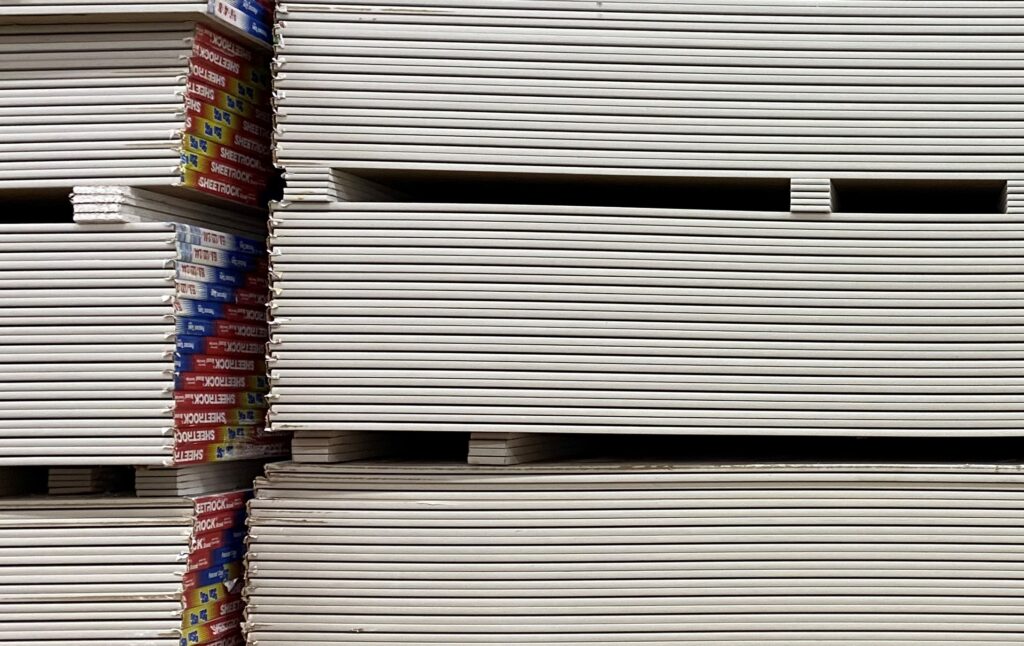
Is There Something Other Than Drywall?
Before drywall, there was plaster. Plaster was widely used in home construction in the 19th century to finish off the home’s interior walls. Plaster was cheap to make but heavy, wet, cumbersome, and slow to finish.
Looking much like thick sticky mud, plaster had to be applied to surfaces and allowed to dry and cure slowly over time. As a building material, it was prone to cracking and chipping.
If used too thick, it could slide off as it dried or be prone to cracking. If the coat of plaster was applied too thin, it could chip and disintegrate easily.
There were also issues with transporting and preparing the plaster, as it was cumbersome and challenging to work with. But before the invention of drywall, plaster was the leading material used in construction for that finishing work inside the home.
Why is Drywall so Popular in Construction?
There are several reasons why drywall continues to be the most sought-after material for interior work. Here are just a few of the perks that come from using this innovative building material:
· Less labor means lower costs overall for any project.
· The durability of the drywall has been a central selling point for the product since it first became popular. It is strong enough to add additional support and stability to the walls, making them last longer. Plus, drywall is versatile and can be cut, sized, and installed in many ways, giving it a considerable advantage over plaster.
· Because drywall has a combination of Calcium Sulfate plus water (CaSo4+H2O), it can be fire and water-retardant to a certain extent. The materials are slow to ignite and burn, which can slow fire spread. Additionally, the surface is water resistant, so damage from water is slower to take hold as well. Some building and construction experts see it as the most effective defense against fire and water.
· Drywall is cost-effective, durable, and easy to maintain. It demands less labor to install, and less drywall is needed to achieve the same look and insulation as plaster provides. Drywall also is easy to keep clean and maintain, regardless of where it is used.
· Drywall is customizable, perhaps one of its best selling points for homeowners. The material can easily be modified to meet specific design needs and to fit trouble areas. The personalization features enable designers and builders to offer exact sizing and design elements to fit home or office architecture.

Is drywall safe to use in homes and businesses?
Aside from the initial concerns about dust and particulates getting into the air during installation and renovation or construction work, drywall is considered safe for humans and animals.
Drywall and similar materials now use gypsum rather than asbestos, which is much safer and has a much lower potential for health impacts over time.
When work does need to be done, it is best to call in experts in the construction industry who know how to work with drywall. These can easily be vacuumed and washed away when the job is done.
How long will drywall last once it is installed?
Drywall is made to be durable and to hold up to the normal wear and tear of home and office life. Factors such as environment, maintenance, and upkeep can shorten or extend the lifespan of it in your building.
However, a general timeframe for how long drywall can last when properly cared for is 30 to 40 years.
Suppose there has been flooding, water damage, or a fire has caused smoke damage to the drywall. In that case, it is best to replace the damaged and affected areas to ensure the longevity and stability of the drywall in general.
Residential and commercial construction experts can help ensure all needs and concerns are adequately addressed.
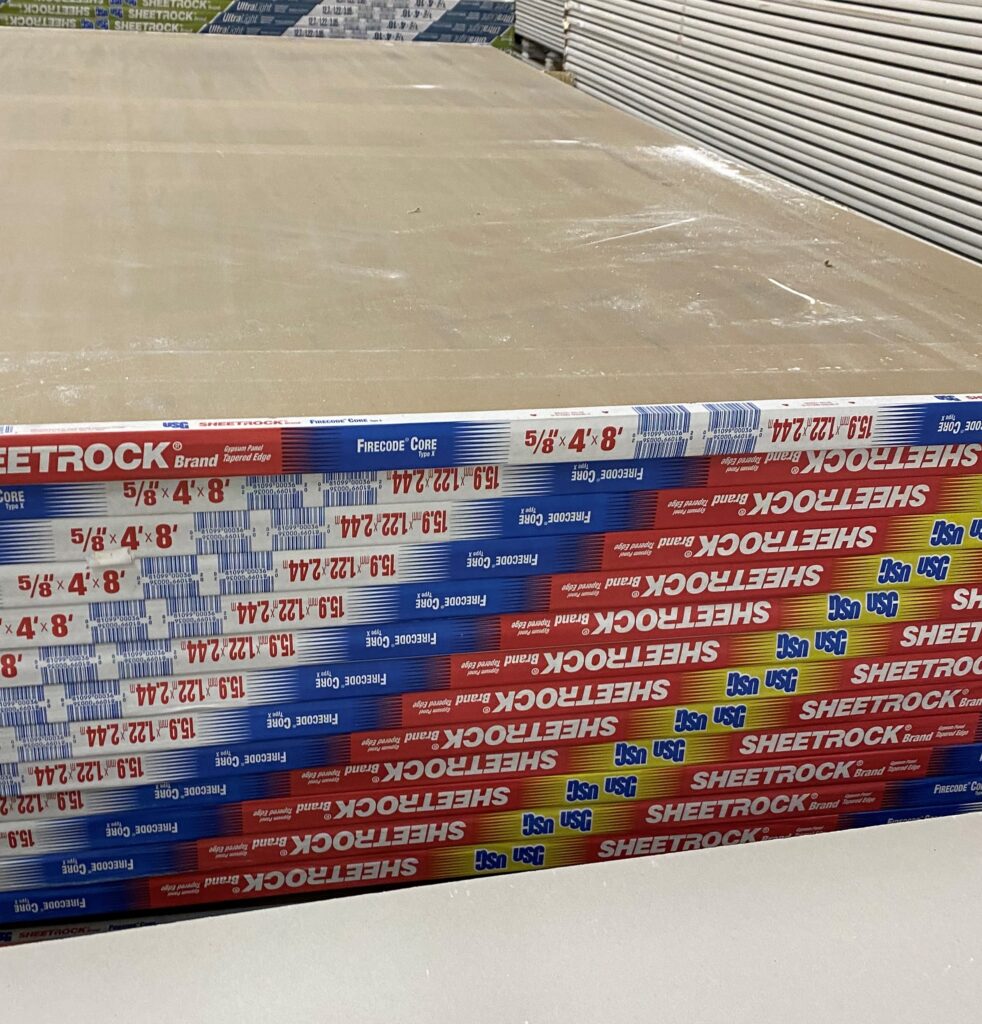
What is the average cost of drywall installation?
The typical drywall cost is between $12 and $20 per panel, with a national average of $15. The prices can vary depending on where in the country the project takes place and what size sheets you are buying.
It is also important to remember that these figures are only for the drywall itself. Additional transportation costs could influence the price. And it is essential to remember that labor costs to handle and install the drywall is in addition to this bottom line cost for the drywall needed for your project.
Call local construction industry professionals today and see what drywall can do for your residential or commercial building construction and remodeling needs.
